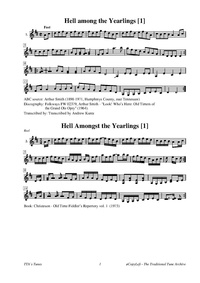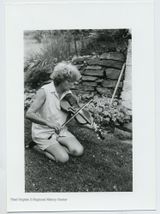Template:Pagina principale/Vetrina: Difference between revisions
No edit summary |
No edit summary |
||
| Line 1: | Line 1: | ||
{{SheetMusic | {{SheetMusic | ||
|f_track= | |f_track=Hell Among the Yearlings.mp3 | ||
|f_pdf= | |f_pdf=Hell Among the Yearlings.pdf | ||
|f_artwork= | |f_artwork=Singleton.jpg | ||
|f_tune_name= | |f_tune_name=Hell Amongst the Yearlings | ||
|f_track_title= | |f_track_title=Hell_Amongst_the_Yearlings_(1) | ||
|f_section=abc | |f_section=abc | ||
|f_played_by=[https://soundcloud.com/ | |f_played_by=[https://soundcloud.com/theozarkhighballers The Ozark Highballers] | ||
|f_notes= | |f_notes= Folk Musician Sarah Singleton Playing the Fiddle, Heater, W. Va., July, 1973. | ||
|f_caption= | |f_caption=Several unrelated tunes in various parts of the United States carry the name "Hell Among(st) the Yearlings," so obviously a memorable title in rural communities. The title has itself aroused some speculation. It is thought by some to represent 'trouble with the cattle'-yearlings being young cattle that are bred for the first time and quite rambunctious. | ||
|f_source=[https://soundcloud.com/ | |f_source=[https://soundcloud.com/theozarkhighballers/hell-among-the-yearlings Soundcloud] | ||
|f_pix=420 | |f_pix=420 | ||
|f_picpix=200 | |f_picpix=200 | ||
|f_article=[[ | |f_article=[[Hell_Amongst_the_Yearlings_(1) | '''Hell Amongst the Yearlings''']] | ||
Several unrelated tunes in various parts of the United States carry the name "Hell Among(st) the Yearlings," so obviously a memorable title in rural communities. The title has itself aroused some speculation. It is thought by some to represent 'trouble with the cattle'-yearlings being young cattle that are bred for the first time and quite rambunctious. | |||
Another interpretation hinges on 'hell' as a term for dense underbrush and thicketed country, with the title meaning that the yearlings are in the underbrush, thus making it quite a chore to round them up. Chicago musician Paul Tyler made the following comments (Fiddle-L, 5/10/04). | |||
<blockquote> | |||
''In 1939, Edgar Lee Masters (of Spoon River fame) published in Esquire an'' | |||
''account of a visit he made with Theodore Dreiser to the home fiddler'' | |||
''John Armstrong in Oakford, Illinois. The account reappeared in Masters''' | |||
''book The Sangamon in the Rivers of America series. Masters grew in'' | |||
''Menard County where Armstrong lived. The visit was made in 1916, two'' | |||
''decades before the account was published, so you have to allow for the'' | |||
''author's creativity to have been at work on the memories. Here's'' | |||
''Masters' words of what John Armstrong had to say about Hell:''<br> | |||
<br> | |||
''We asked for "Turkey in the Straw" again, and John played it with'' | |||
''spirit. Then he played "Hell Amongst the Yearlings." "This here is'' | |||
''called 'Hell Amongst the Yearlings.' I don't ricollect what it was'' | |||
''furst called; but they had a dance over at Ben Sutton's oncet, and while'' | |||
''they was a-dancin' the cattle broke into his corn. So ever since they'' | |||
''have called it 'Hell Amongst the Yearlings.'" John furnished us with'' | |||
''evidence of the manner in which tales and sayings grow up, and by that'' | |||
''token how myths originate and flourish.'' | |||
</blockquote> | |||
The first strain is generally played in nine measures instead of the usual eight, although there are exceptions (c.f. Sarah Singleton's versions). The second strain varies and is seldom similar from region to region or collection to collection. | |||
}} | }} | ||
Revision as of 11:56, 11 February 2023

Played by: The Ozark Highballers
Source: Soundcloud
Image: Folk Musician Sarah Singleton Playing the Fiddle, Heater, W. Va., July, 1973.

Several unrelated tunes in various parts of the United States carry the name "Hell Among(st) the Yearlings," so obviously a memorable title in rural communities. The title has itself aroused some speculation. It is thought by some to represent 'trouble with the cattle'-yearlings being young cattle that are bred for the first time and quite rambunctious.
Another interpretation hinges on 'hell' as a term for dense underbrush and thicketed country, with the title meaning that the yearlings are in the underbrush, thus making it quite a chore to round them up. Chicago musician Paul Tyler made the following comments (Fiddle-L, 5/10/04).
In 1939, Edgar Lee Masters (of Spoon River fame) published in Esquire an account of a visit he made with Theodore Dreiser to the home fiddler John Armstrong in Oakford, Illinois. The account reappeared in Masters' book The Sangamon in the Rivers of America series. Masters grew in Menard County where Armstrong lived. The visit was made in 1916, two decades before the account was published, so you have to allow for the author's creativity to have been at work on the memories. Here's Masters' words of what John Armstrong had to say about Hell:
We asked for "Turkey in the Straw" again, and John played it with spirit. Then he played "Hell Amongst the Yearlings." "This here is called 'Hell Amongst the Yearlings.' I don't ricollect what it was furst called; but they had a dance over at Ben Sutton's oncet, and while they was a-dancin' the cattle broke into his corn. So ever since they have called it 'Hell Amongst the Yearlings.'" John furnished us with evidence of the manner in which tales and sayings grow up, and by that token how myths originate and flourish.
The first strain is generally played in nine measures instead of the usual eight, although there are exceptions (c.f. Sarah Singleton's versions). The second strain varies and is seldom similar from region to region or collection to collection.
...more at: Hell Amongst the Yearlings - full Score(s) and Annotations
X:1 T:Hell among the Yearlings [1] M:C| L:1/8 Q:"Fast" S:Arthur Smith (1898-1971, Humphreys County, east Tennessee) D:Folkways FW 02379, Arthur Smith - "Look! Who's Here: Old Timers of D:the Grand Ole Opry" (1964). F:https://www.slippery-hill.com/recording/indian-creek-0 Z:Transcribed by Andrew Kuntz K:D V:1 clef=treble name="1." [V:1] Ac|defd efde|fdeg fdBc| defd efdA | cBcB A2Ac| dcde fded|BG[GB][GA][G4B4]|FG A2a3b|afed cBAG | FDDD D2:|| |:[GA]-|[A2A2]BA [F2A2][F2A2]|ABAF D4|+slide+A,2EE C2EE|A,2E2C2E2| FA A2 BABc|dBAG FAFD|A,G,A,B, CDEC|D2D4:|]
